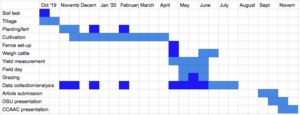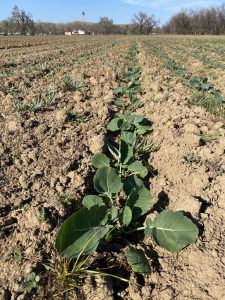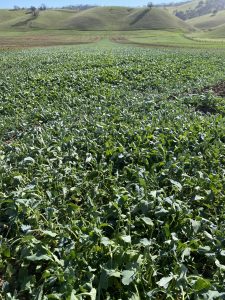Progress report for FW19-346
Project Information
Grazing of annual brassicas to extend grazing season in summer-dry pastures in Northern California.
Lack of summer rainfall leads to a paucity of annual grass forage in the summer months in the Brentwood region. Cattle are generally fed alfalfa hay during this time. However, the cultivation of alfalfa has proven to be ecological costly in both water and carbon footprint. By utilizing brassica forage crops as cattle forage in May and June, we hope to reduce costs, environmental impact per head, and improve pasture fertility. Planted brassicas will allow a greater percent of cattle feed to be produced on site and in turn keep more of the fertility and nutrients cycling within the farm system.
In a 20 acre trial, we will test three different brassica species over three different winter seeding dates. No tillage will be performed to avoid erosion and soil disturbance. Cattle will be strip grazed across the plots using electric fencing. Data to be collected includes: dry matter yields, plant phenology information, forage nutritional quality, cost of production, and live weight gain of cattle. We will compare the cost of production to hay fed cattle. Dissemination of findings will be achieved through social media, on farm field days, written publications, and presentations.
We planted our first trial plots on December 19th 2019 using turnips, kale and swedes. We had very little rainfall which led to a later than anticipated planting date.
Our second round of planting was done on January 14th 2020 using turnips, Kale and swedes. Rainfall was plentiful in January and we had trouble finding a dry window to plant.
We did not plant in February as was prescribed from our project outline, due to a complete lack of rain. Lack of rain has been a real problem for this project. The swedes are small but look healthy. The kale looks wilted from the lack of moisture and the turnips may have died. Rain is now in the forecast and we will see if it is enough to bring this trial back to life.
- Quantify the efficacy of grazing cattle on brassicas in summer-dry pastures of Northern California as compared to hay feeding based on cost.
- Quantify the forage production, nutritive value and animal liveweight gains from brassica pastures and alfalfa supplemental feeding systems.
- Actively share results with local extension agents, ranchers, farmers, industry organizations, and private consultants during the trial and after the data has been collected and analyzed.


Cooperators
- - Technical Advisor
- - Producer
Research
Site: The site of the experiment is Brentwood, in Contra Costa County, California. Cody leases land in this area and has set aside 20 acres for this trial. The 20 acres are divided into three equal plots, each 300’x950’. Within each of these plots, three different brassica crops will be tested. Each subplot of brassica species will be seeded 100’x950’. See figure 1. The trial will be planted only as demonstration plots with no replication. Figure-1.-Test-site-layout
Brassica establishment:
Soil preparation and planting: Three separate soil tests will be taken within the 20 acre paddock to establish necessary fertilizer requirement prior to each planting date. Brassica seeds will be direct-drilled into the soil by a no-till seeder. Cattle will graze down the plots in the weeks prior to planting in order to prepare the site for the drill. Fertilizer will be applied at a rate commensurate to the recommendations of a soil test, and applied at the time of seeding. The tractor to pull the seed drill will be rented from a local equipment rental service, Cody owns the drill. The brassica species chosen are purple top turnips, daikon radishes, and bayou kale; all seed will be sourced from Saddle Butte Ag. The three planting dates are mid-November, late December and early February, exact dates will be determined by tractor availability and weather. The plots will be managed under rainfed conditions without supplemental irrigation. Because of the quick germination of brassicas and lack of tillage in this trial, they should be able to compete with most weeds. Organic certified herbicide may be applied late in growing season depending on the state of the field.
Grazing management: In order to compare the animal production and cost of feeding on brassicas to feedlots stocker cattle into two groups according to their body condition scores, age and liveweight and allocated randomly to brassica paddocks and feedlot. The stocking density will be determined by the amount of dry matter produced by late April or early May. We hope to achieve yields of 5-6 tons DM/acre. At that rate 250 cattle can be grazed in this trial, with each head of cattle eating 2.5% of its body weight per day. The stocker cattle for this trial will be 7-12 months in age and around 700 lbs.
We expect to move the cattle on to the first section of the field in early May. Cows will be transitioned onto the pastures over 7 days, increasing the forage offered by 5 lbs DM every two days. All plots will be strip-grazed commonly by a one herd of stocker cattle using 14-gauge wire electric fencing. The approximate size of a paddock is five acres, although subject to change based on the yield and size of cattle. We plan to graze the cattle for a total of six weeks on the brassica crops. The planned fence is outlined in Figure 1. Cody will manage the grazing during the brassica trial, he has an employee located in Brentwood that tends to the cattle while they are on the annual grasses during the rest of the year.
Measurements and cost analysis:
Dry Matter yields, plant phenology and nutritional quality: Pre-grazing forage mass (dry matter) of brassica crops will be determined prior to the start of grazing and then at three-week intervals until the end of grazing. This will be done by harvesting pre-grazed forage material to ground level (including the bulbs) in five randomly positioned 10 ft2 quadrats per plot. This will result in 15 samples per each seeding date plot and 45 samples overall. The fresh weight of the bulk sample will be recorded in the field and a representative subsamples will be retained to determine total DM. Post-grazing DM will be determined in weeks 1, 3 and 6 by harvesting residual forage matter in five randomly placed 10 ft2 quadrats in areas that had been grazed the previous weeks. All crop residues within the quadrat will be collected, and washed to remove soil, feces, and dead material.
Forage samples will be sent to DairyOne in Ithica, NY for DM contents, protein, digestibility, and total digestible nitrogen analyses. The plant’s morphological change from a vegetative to reproductive stage indicates a decrease in the nutritional value of the forage. We will record the date of flower for each plot in the experiment.
Liveweight gains of cattle: Cattle will be weighed prior to and at the end of grazing. Liveweight gain per head will be calculated from the change in weight between each measurement. Liveweight gain per acre will be calculated by multiplying liveweight gain per head by the number of cattle per acre.
Cost analysis:Expenses will be expressed as $/lb of growth for each of the two systems. We estimate the break even cost in the brassica trial to be $.30-.40/lb of growth. Costs will be calculated as described in Table 1.
Table 1. Production costs of Brassica fed and hay fed cattle
|
Costs |
Measured in dollars |
Measured in hours* |
|
Brassica Trial |
Seeds, fuel, equipment rental |
Feed labor, fence labor, cultivation/planting labor |
|
Hay Fed |
Hay |
Feed labor |
*Labor units can be converted into dollars using salary data dependent on the farm/farmer.
Successful completion of this project is detailed as follows:
- Brassica crops averaging 5 tons/acre.
- Maintained health and growth of cattle during experiment.
- Documentation of crop yields and planting date influences on crop value.
- Produce a cost comparison between hay fed and brassica grazed cattle.
- Active dissemination of findings.
Research Outcomes
Education and Outreach
Participation Summary:
To disseminate the results of this trial I plan to reach out to ranchers, farmers, researchers, and extension agents in the following ways:
Social media: To connect with the general public and producers far and wide, I plan to document and share each noteable stage of this grazing trial on my social media platform.Based on the commentary on social media I have received about my current WSARE funded project trialing fodder beets in eastern Oregon, I am confident that my audience is engaged in my work. Producers and consumers are interested in alternatives to the parochial options provided by the industrial agricultural system.
Conferences: I will apply to present my findings at the California Cattlemen’s Association Annual Convention in November 2020. There will be a large audience of ranchers to whom my trial is particularly pertinent because they work in a similar climate and industry.
Workshops: Cody will present a report on California fodder crop progress to a group of ranchers in Puyallup, Washington for the Pierce Conservation District on March 10th.
Written texts: John Marble, a contributor to the magazines Stockman Grass Farmer, Graze and On Pasture, has offered to do a write up of this trial in each of these publications. Each of these publications has the potential to reach thousands of producers. I will also produce a fact sheet or poster as written material to distribute at presentations and to other pertinent parties.
OSU presentation: Serkan and Cody will present the findings of this trial at Oregon State University in the fall of 2020. Colleagues, students and other interested parties in the College of Agricultural Sciences will be invited. The video of this presentation and the accompanying powerpoint will be uploaded to Serkan’s class website.
Field day: Beef production is regionally relevant in the area that surrounds Brentwood. Neighboring ranchers and farmers will be invited to field day in late May 2019, after the dry matter analyses have been collected and the cattle have begun to graze the brassica crops. We will discuss any observations and findings to date, in addition to our experimental design and experience setting up a grazing trial.

